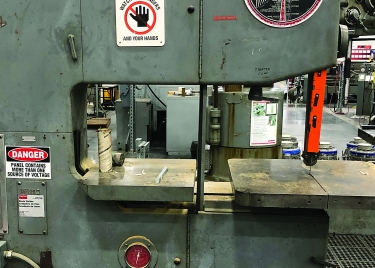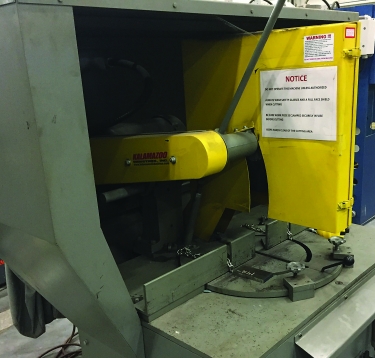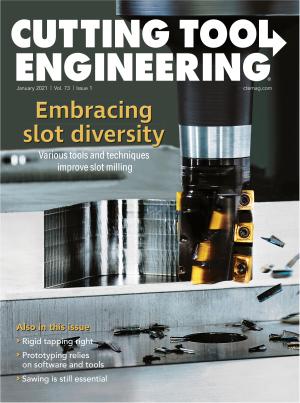An old toolmaker once told me that the lathe is the foundation of a machine shop. He said operating a shop without a lathe would be impossible because it was used for more jobs than any other machine. I was very green at the time, so I took his words as the truth. But after many years of machining, including starting three machine shops from scratch, I have discovered he may have been exaggerating a little. If I could go back and have the conversation again, I would argue that sawing operations are the foundation of a machine shop.
Most workpieces come from shapes like angle iron or larger bulk materials, such as round bar, flat bar, sheet and plate, and sawing is by far the most efficient method for separating workpieces from bulk materials.
Some may argue that shearing is better than sawing because it is faster. However, plate shears are good only for shearing flat materials. Angle iron, channel and round bar can be sheared with machines like ironworkers and bar shears, but these machines cut a limited number of shapes and sizes. Tubes also may be sheared but strictly with specialized machines that can be justified by very large production quantities.

Vertical bandsaws are ideal for rough-cutting features before going to a mill. CNC vertical bandsaws called plate saws are common at steel warehouses. Image courtesy of C. Tate
Shearing always causes some amount of edge deformation. As the diameter or thickness of a material increases, so does the amount of deformation. Edge deformation can result in extra machining, increased handwork or a poor fit during fabrication.
Benefits of Sawing
A saw can cut many sizes of bar and is limited only by the size of stock that will fit physically into a machine. Saws also are capable of cutting an infinite number of shapes as long as a piece may be clamped. In addition, saws can be tooled up to cut odd shapes, whereas ironworkers and shears are dedicated to specific shapes. Saws do not cause edge deformation, and a good saw delivers very clean cuts and square ends. Shearing machines are definitely faster, but a saw is more flexible and provides a better cut.
Bandsaws, cold saws (aka circular saws) and abrasive saws are common types of saws, and each has many different combinations of blade materials, styles and sizes to choose from. Of course, there are numerous kinds of blades for cutting metals, plastics and wood, but blades also are made specifically for cutting materials like fiberglass, rubber and ceramics. There are saws and blades for every application. All these variations give an endless combination of possibilities, making sawing a universal operation.
With the proliferation of multitasking machines and lathes with live tools, sawing operations easily can be carried out on other types of machines. Combining a sawing operation with a bar feeder or bar puller gives the ability to run lathes unattended. Thin-walled or delicate parts can be damaged by a parting tool. Replacing the parting tool with a saw may mitigate the risk of damage to delicate parts. Sawing can be faster than parting because a constant surface speed is maintained and a saw has more active cutting edges.

Abrasive saws are fast and easy to use. They are as accurate as other types of saws but dirty. Image courtesy of C. Tate
Operational costs for a saw are low, and sawing operations are usually economical. Consumable items like saw blades are rather inexpensive and have a long life compared with other cutting tools, such as endmills and drills. Maintenance intervals are infrequent, and spare parts are priced reasonably relative to other types of machines. Adding the options necessary to make a saw automatic is often inexpensive and allows the saw to run unattended, further improving low operating costs.
Sawing is also a very efficient way to prepare workpieces for other machining operations and reduce machining costs. It is common practice at a toolroom to lay out a workpiece on a surface plate and use a bandsaw to remove large pieces before going to a mill. Making a few cuts on the bandsaw can significantly reduce milling time and tooling costs. Hole saws are a great substitute for drills when making large-diameter holes in thin materials as drills tend to damage the stock, and slitting saws are a much better choice than endmills for milling deep, narrow grooves.
Sawing may be the most common manufacturing process at machine shops. It is versatile, simple and reliable. Many young engineers and machinists I meet are very familiar with laser and waterjet cutting but have no knowledge of sawing. Although arguably less interesting than some newer technologies, sawing is still a vital machining operation at modern machine shops.
Related Glossary Terms
- abrasive
abrasive
Substance used for grinding, honing, lapping, superfinishing and polishing. Examples include garnet, emery, corundum, silicon carbide, cubic boron nitride and diamond in various grit sizes.
- bandsaw
bandsaw
Machine that utilizes an endless band, normally with serrated teeth, for cutoff or contour sawing. See saw, sawing machine.
- ceramics
ceramics
Cutting tool materials based on aluminum oxide and silicon nitride. Ceramic tools can withstand higher cutting speeds than cemented carbide tools when machining hardened steels, cast irons and high-temperature alloys.
- computer numerical control ( CNC)
computer numerical control ( CNC)
Microprocessor-based controller dedicated to a machine tool that permits the creation or modification of parts. Programmed numerical control activates the machine’s servos and spindle drives and controls the various machining operations. See DNC, direct numerical control; NC, numerical control.
- flat ( screw flat)
flat ( screw flat)
Flat surface machined into the shank of a cutting tool for enhanced holding of the tool.
- gang cutting ( milling)
gang cutting ( milling)
Machining with several cutters mounted on a single arbor, generally for simultaneous cutting.
- gang cutting ( milling)2
gang cutting ( milling)
Machining with several cutters mounted on a single arbor, generally for simultaneous cutting.
- lathe
lathe
Turning machine capable of sawing, milling, grinding, gear-cutting, drilling, reaming, boring, threading, facing, chamfering, grooving, knurling, spinning, parting, necking, taper-cutting, and cam- and eccentric-cutting, as well as step- and straight-turning. Comes in a variety of forms, ranging from manual to semiautomatic to fully automatic, with major types being engine lathes, turning and contouring lathes, turret lathes and numerical-control lathes. The engine lathe consists of a headstock and spindle, tailstock, bed, carriage (complete with apron) and cross slides. Features include gear- (speed) and feed-selector levers, toolpost, compound rest, lead screw and reversing lead screw, threading dial and rapid-traverse lever. Special lathe types include through-the-spindle, camshaft and crankshaft, brake drum and rotor, spinning and gun-barrel machines. Toolroom and bench lathes are used for precision work; the former for tool-and-die work and similar tasks, the latter for small workpieces (instruments, watches), normally without a power feed. Models are typically designated according to their “swing,” or the largest-diameter workpiece that can be rotated; bed length, or the distance between centers; and horsepower generated. See turning machine.
- milling
milling
Machining operation in which metal or other material is removed by applying power to a rotating cutter. In vertical milling, the cutting tool is mounted vertically on the spindle. In horizontal milling, the cutting tool is mounted horizontally, either directly on the spindle or on an arbor. Horizontal milling is further broken down into conventional milling, where the cutter rotates opposite the direction of feed, or “up” into the workpiece; and climb milling, where the cutter rotates in the direction of feed, or “down” into the workpiece. Milling operations include plane or surface milling, endmilling, facemilling, angle milling, form milling and profiling.
- milling machine ( mill)
milling machine ( mill)
Runs endmills and arbor-mounted milling cutters. Features include a head with a spindle that drives the cutters; a column, knee and table that provide motion in the three Cartesian axes; and a base that supports the components and houses the cutting-fluid pump and reservoir. The work is mounted on the table and fed into the rotating cutter or endmill to accomplish the milling steps; vertical milling machines also feed endmills into the work by means of a spindle-mounted quill. Models range from small manual machines to big bed-type and duplex mills. All take one of three basic forms: vertical, horizontal or convertible horizontal/vertical. Vertical machines may be knee-type (the table is mounted on a knee that can be elevated) or bed-type (the table is securely supported and only moves horizontally). In general, horizontal machines are bigger and more powerful, while vertical machines are lighter but more versatile and easier to set up and operate.
- multifunction machines ( multitasking machines)
multifunction machines ( multitasking machines)
Machines and machining/turning centers capable of performing a variety of tasks, including milling, drilling, grinding boring, turning and cutoff, usually in just one setup.
- parting
parting
When used in lathe or screw-machine operations, this process separates a completed part from chuck-held or collet-fed stock by means of a very narrow, flat-end cutting, or parting, tool.
- sawing
sawing
Machining operation in which a powered machine, usually equipped with a blade having milled or ground teeth, is used to part material (cutoff) or give it a new shape (contour bandsawing, band machining). Four basic types of sawing operations are: hacksawing (power or manual operation in which the blade moves back and forth through the work, cutting on one of the strokes); cold or circular sawing (a rotating, circular, toothed blade parts the material much as a workshop table saw or radial-arm saw cuts wood); bandsawing (a flexible, toothed blade rides on wheels under tension and is guided through the work); and abrasive sawing (abrasive points attached to a fiber or metal backing part stock, could be considered a grinding operation).
- sawing machine ( saw)
sawing machine ( saw)
Machine designed to use a serrated-tooth blade to cut metal or other material. Comes in a wide variety of styles but takes one of four basic forms: hacksaw (a simple, rugged machine that uses a reciprocating motion to part metal or other material); cold or circular saw (powers a circular blade that cuts structural materials); bandsaw (runs an endless band; the two basic types are cutoff and contour band machines, which cut intricate contours and shapes); and abrasive cutoff saw (similar in appearance to the cold saw, but uses an abrasive disc that rotates at high speeds rather than a blade with serrated teeth).
- waterjet cutting
waterjet cutting
Fine, high-pressure (up to 50,000 psi or greater), high-velocity jet of water directed by a small nozzle to cut material. Velocity of the stream can exceed twice the speed of sound. Nozzle opening ranges from between 0.004" to 0.016" (0.l0mm to 0.41mm), producing a very narrow kerf. See AWJ, abrasive waterjet.


